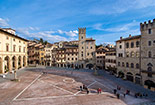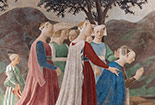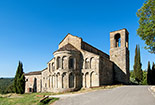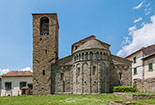The Parish Church of Saint Mary
in Arezzo, Tuscan art city that you can know in every detail with this website
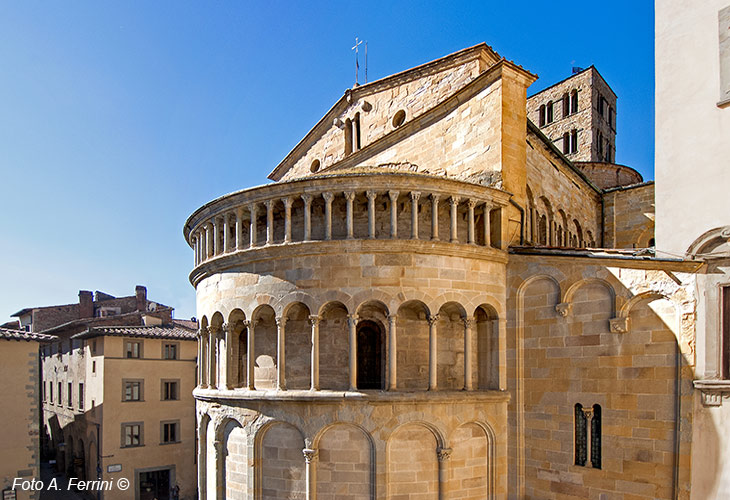
Texts and photos by Alessandro Ferrini ©
50 accurately described images of Pieve di Arezzo. Click to enlarge
The Parish Church of Arezzo, an extraordinary example of Romanesque architecture
 Being characterized by a remarkable height and extraordinary architecture, the bell tower of the Parish Church of Santa Maria in Arezzo is considered a symbol and a landmark of this Tuscan city of art. As we approach this church, we realize that, in addition to being a building with a wonderful architecture, it could be defined as a gigantic and extraordinary sculpture. In fact, hundreds of finely worked columns with refined capitals decorate its facade and the large apse. On these two architectural parts of the church and on the right side there are also many other sculptures. The beautiful and pleasant allegories of the twelve months placed above the central door of the facade are to be noted. These sculptures, due to their position, often go unnoticed by the visitor.
Being characterized by a remarkable height and extraordinary architecture, the bell tower of the Parish Church of Santa Maria in Arezzo is considered a symbol and a landmark of this Tuscan city of art. As we approach this church, we realize that, in addition to being a building with a wonderful architecture, it could be defined as a gigantic and extraordinary sculpture. In fact, hundreds of finely worked columns with refined capitals decorate its facade and the large apse. On these two architectural parts of the church and on the right side there are also many other sculptures. The beautiful and pleasant allegories of the twelve months placed above the central door of the facade are to be noted. These sculptures, due to their position, often go unnoticed by the visitor.
The construction of the Parish Church of Arezzo began around the middle of the twelfth century and occupied the place of an older baptismal church in the city, smaller but placed in the usual position, between today's Corso Italia and Piazza Grande. The shape and size of the church were those we see today, but the facade was simpler and more linear. What we can admire today, which resembles the Romanesque style present in the territory of Pisa, was built in the thirteenth century, in the same period in which was built the high bell tower (almost sixty meters) integrated on the front right corner of the church. The bell tower was finished in 1330.
The external view of the parish church of Santa Maria Assunta in Arezzo tells us that this is one of the most extraordinary examples of Romanesque architecture in Tuscany and beyond.  The interior does not betray expectations. We are immediately struck by the remarkable height of the three naves in which the church is divided, the only Romanesque in these proportions in the territory of Arezzo. Columns and pillars, at the top of which are highly worked capitals on which rest round arches, divide the three naves. The sacred building shows an original architectural solution compared to other churches in Arezzo, the presbytery is well raised. Underneath this there is the crypt, on the altar of this there is a reliquary bust of St. Donatus.
The interior does not betray expectations. We are immediately struck by the remarkable height of the three naves in which the church is divided, the only Romanesque in these proportions in the territory of Arezzo. Columns and pillars, at the top of which are highly worked capitals on which rest round arches, divide the three naves. The sacred building shows an original architectural solution compared to other churches in Arezzo, the presbytery is well raised. Underneath this there is the crypt, on the altar of this there is a reliquary bust of St. Donatus.
The interior architecture of the parish church of Arezzo is extraordinary. This captures the visitor's attention also because it can be observed from different points of view, from the bottom of the church as well as from various areas of the great raised presbytery. Due to the internal beauty of this sacred building, other architectural and artistic elements present here risk being overshadowed, even though they are of high value.
Turning clockwise inside the church, in the corner between the counter-façade and the left wall, we find two bas-reliefs in marble by an unknown artist dating back to the 13th century. In one is carved the figure of St. Joseph. To the left of the saint, above it is shown the Nativity, below it is seen Jesus Child in a tub while the bath is practiced to him. In the other bas-relief we can see three small figures identifiable as the Magi parading in adoration before Jesus sitting on the knees of the Virgin.
Halfway through the church, on the left wall, there is the door leading to the Chapel of the Blessed Sacrament, frescoed by the painter Luigi Ademollo at the beginning of the 19th century. On the left pillar that supports the presbytery there is a fresco of the '300 attributed to Andrea di Nerio depicting St. Francis and St. Dominic. Going up the presbytery through the left staircase, behind the bishop's seat of the sixteenth century is a beautiful  Crucifix painted by Margaritone d'Arezzo dating from the last years of the thirteenth century. At the center of the presbytery is placed as an altarpiece the beautiful polyptych by the Sienese painter Pietro Lorenzetti, a painting in tempera and gold on wood of 1320.
Crucifix painted by Margaritone d'Arezzo dating from the last years of the thirteenth century. At the center of the presbytery is placed as an altarpiece the beautiful polyptych by the Sienese painter Pietro Lorenzetti, a painting in tempera and gold on wood of 1320.
Coming down from the presbytery with the right staircase we find on the wall a beautiful nineteenth-century stained glass window, but before returning to the entrance we can visit the beautiful and large crypt located under the presbytery. Back along the right wall, we find a beautiful wooden crucifix by an unknown author dating from the seventeenth century. Finally we find the baptistery of the parish church located in the corner between the right wall and the counter-façade, under the bell tower. The Baptismal Font in stone has three large finely carved marble panels. For this reason it is considered an important work of the fourteenth century.
The artistic and architectural elements mentioned in this quick tour inside the Parish Church of Arezzo are almost all visible and more described in the pages in sequence of this web section.



